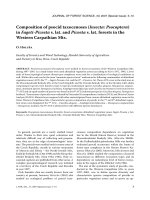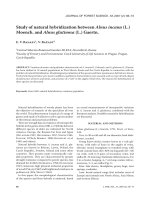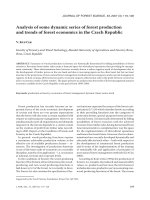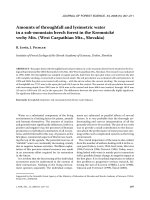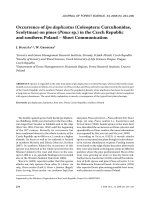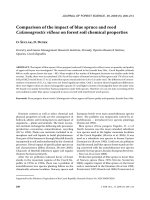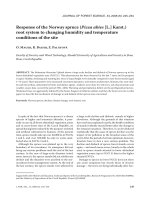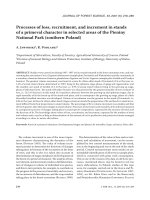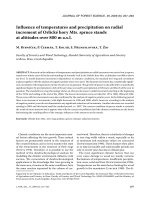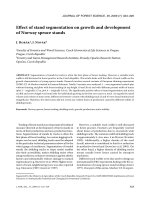Báo cáo lâm nghiệp: "Roles of European and Japanese larch in the genetic control of growth, architecture and wood quality traits in interspecific hybrids (Larix × eurolepis Henry)" pot
Bạn đang xem bản rút gọn của tài liệu. Xem và tải ngay bản đầy đủ của tài liệu tại đây (541.34 KB, 9 trang )
25
Ann. For. Sci. 61 (2004) 25–33
© INRA, EDP Sciences, 2004
DOI: 10.1051/forest:2003081
Original article
Roles of European and Japanese larch in the genetic control
of growth, architecture and wood quality traits in interspecific hybrids
(Larix × eurolepis Henry)
Luc E. PÂQUES*
INRA, Unité d’Amélioration, de Génétique et de Physiologie des Arbres forestiers, 45166 Olivet Cedex, France
(Received 7 November 2001; accepted 23 December 2002)
Abstract – The respective roles of European and Japanese larch species in the genetic control of traits in interspecific hybrids are examined.
Two incomplete factorial mating design experiments involving European larch clones of Sudetan origin as the female parent and Japanese larch
clones as the male parent have been used for that purpose. Traits investigated include growth, architecture and wood quality parameters up to
16 years old. Results indicate that traits can be grouped into three categories according to the level of control by parental species: (i) height
growth controlled nearly equally by both parents, (ii) BH diameter, stem volume and architecture traits under a strong Japanese larch control
and (iii) wood quality parameters predominantly controlled by the European larch. Several traits showed moderate to high full-sib family
heritabilities (over 0.8): total height, stem volume, branch angle and wood density, while others like heartwood proportion, taper, density of
branching or stem straightness showed low values. Several traits appear to be under non-negligible non-additive genes effects: heartwood
proportion, taper, stem straightness, BH girth and modulus of elasticity. Implications for further breeding are discussed.
Larix / hybridisation / heritability / growth / stem form / wood properties
Résumé – Contribution du mélèze d’Europe et du mélèze du Japon dans le contrôle génétique de la croissance, de l’architecture et de
la qualité du bois chez le mélèze hybride (Larix × eurolepis Henry). Cette étude examine l’importance relative du mélèze d’Europe et du
mélèze du Japon dans le contrôle génétique des caractères chez le mélèze hybride. Deux plans de croisements factoriels incomplets sont
analysés : ils impliquent des clones de mélèze d’Europe, originaires des Sudètes, comme parents femelles et des clones de mélèze du Japon
comme parents mâles. Les caractères étudiés comprennent des paramètres de croissance, d’architecture et de qualité du bois entre 2
et 16 ans.
Les principaux résultats indiquent que ces caractères peuvent être groupés en 3 catégories suivant le degré de contrôle de chacune des 2 espèces
parentales : (i) la croissance en hauteur contrôlée à part sensiblement égale par les 2 espèces, (ii) la croissance en diamètre et en volume et les
paramètres d’architecture sous déterminisme fort du mélèze du Japon, et (iii) les propriétés du bois sous contrôle du mélèze d’Europe. Plusieurs
caractères présentent des héritabilités (au niveau familles de pleins-frères) fortes (> 0.8) : hauteur, volume, angle des branches, densité du bois
par opposition à d’autres comme le pourcentage de duramen, l’élancement, la densité de branchaison ou la rectitude de la tige. Plusieurs
paramètres également sont sous l’influence de gènes à caractère non-additif : pourcentage de duramen, élancement et rectitude de la tige,
diamètre, module d’élasticité. Les conséquences sur le choix d’une stratégie d’amélioration sont discutées.
mélèze / hybride / heritabilité / croissance / architecture / propriétés du bois
1. INTRODUCTION
In addition to their roles in native mountainous ranges,
larches are much appreciated for afforestation or reforestation
in lowlands. Besides their fast juvenile growth, larches are val-
ued for their high quality timber, their wind firmness, their
susceptibility to only a limited number of pests and their
amenity. Among larches, hybrids between European (Larix
decidua Mill.) and Japanese (Larix kaempferi (Lamb.) Carr.)
larch seem likely to play an increasing role in north-western
European forestry.
European and Japanese larches appear complementary for
several traits [29]: while Japanese larch is nearly canker resist-
ant and has a faster juvenile growth, European larch is more or
less sensitive to canker and is much more resistant to late frost
and to summer drought than Japanese larch. As well, Japanese
larch has usually a poorer stem form and a coarser branching.
Differences for wood quality parameters have been reported as
well.
Though geographically distant and morphologically dis-
tinct, European and Japanese larches are closely related as sug-
gested by molecular markers in several studies [10, 24, 31, 36].
Interspecific hybrids between these two larches have been
known for more than a century. The two species hybridise eas-
ily and thousands of hybrids have been produced across Europe
in open-pollinated conditions and by controlled crossing.
* Corresponding author:
26 L.E. Pâques
Superiority of hybrids over European or Japanese larch
controls has been described by many authors [e.g. 5, 11, 14,
20, 23, 30] for several traits including phenology, growth,
stem form and wood quality parameters. But, in contrast to
these optimistic results, two major facts must be underlined
regarding interspecific breeding in larch. Firstly, the basic
cause of this superiority has been little documented (comple-
mentation of traits and/or heterosis) and secondly, very few
commercial varieties have been issued from breeding pro-
grammes compared to the large number of combinations pro-
duced. Indeed, as observed in our own interspecific breeding
programme, many hybrids fail to reach the minimum selection
standards for growth, stem form and wood quality [29].
Part of this relatively limited success might be connected to
the inefficiency of phenotypical selection of parent clones
(e.g. hidden stem form defects at age of selection, lack of rela-
tionship between phenotypical and genetic values) as sug-
gested by Keiding and Olsen [15]. Another reason may be the
lack of knowledge of the genetic control of traits in larch inter-
specific hybrids. With a few known exceptions [14, 21, 25, 26],
appropriate mating designs (diallel or factorial mating plans)
are mostly missing and information on quantitative genetic
control of traits is rare. As a result, breeders have currently no
basis to efficiently select candidate parents of hybrids and
hybrid vigour is still mostly unpredictable.
The objective of this study is to report results on genetic
parameters obtained from two interspecific factorial mating
designs. They concern growth, stem architecture and wood
quality traits up to 16 years old from sowing of seed. In partic-
ular, the relative contributions of parental species to total var-
iation is evaluated as well as the relative part of additive versus
non-additive effects in the genetic control of traits. Implica-
tions for further breeding are then discussed.
2. MATERIALS AND METHODS
Two factorial mating designs (12 × 6 and 9 × 7) were created by
controlled crossing in March 1982. Both of them include, as female
clones, a common set of 9 clones out of 12 which were selected in the
native range of the European larch: 11 non-related clones from the
Sudetan Mountains and 1 clone from the Alps. As for the male clones,
two independent sets of clones have been used: 6 non-related clones
of Japanese larch have been used for the first mating design and
7 related clones for the second. The former were phenotypically
selected for growth and stem form from various native Japanese ori-
gins in a provenance trial at 22 years old. The latter were obtained
after two generations of crossings among full-sib parents. All these
clones are part of the INRA breeding populations for European and
Japanese larches.
Creation of mating plans by controlled crossing is usually labori-
ous in larch because of capricious flowering and low seed set [6]. Due
to several failures in crossing, only incomplete mating plans could be
obtained with 30 progenies (out of 72) in the first one (Factorial 1)
and 29 (out of 63) in the second one (Factorial 2). Each parent clone
was involved in at least 2 successful crossings with the other species.
In May 1983, seedlots were sown at INRA nursery in Orléans,
where seedlings were lined out one year later. They were then planted
as bare-root seedlings at a 3 × 3 m spacing in the forest in April 1985.
The experimental site is located in Beaumont-du-Lac (West of Massif
Central Mountain, Haute-Vienne, Longit. 1° 50’ E, Lat. 45° 45’ N, alt.
540 m): plants from the 2 mating designs were inter-mixed in the
same plantation. An incomplete randomised block design with
40 blocks, 42 trees per block and one-tree plot has been used. Full-sib
families include on average 22.4 and 21.5 individuals respectively in
mating plans 1 and 2. No fertilisation was applied and the stand was
not yet thinned at time of last measurements.
From 2 to 16 years old (from sowing), data have been accumulated
through periodic measurements. The main traits evaluated include:
– growth: Total height, BH girth and stem volume. Volume (up to a
top diameter of 7 cm) has been evaluated following [43] using both
BH girth and total height when available or only BH girth.
– stem architecture: Height/BH Diameter ratio (both parameters
expressed in the same unit), stem straightness, branching density and
branch angle. Stem straightness was scored on a 5-point grading sys-
tem with 1: heavily crooked and 5: straight stem; Branching density
was estimated as the ratio of the number of branches on the 1988-
stem increment to the length of that increment and expressed as the
number of branches per 10 cm long shoot; A 4-point grading system
was used to estimate branch angle from the 1988-stem increment with
1 = 0–25° angle up to 4 = 75–100° angle with the stem.
– wood quality: Pilodyn needle penetration, overall wood density,
proportion of heartwood. A 6 J-Pilodyn device was used over bark
with a 2-mm diameter-needle. Overall density was estimated from
intraring density obtained by direct-scanning X-ray densitometry sys-
tem on radial increment cores: only the last 6 rings have been
included in this estimation. The lengths of heartwood and sapwood
along two small boards cut in two opposite radial cores were meas-
ured based on eye-visible colour differentiation of the wood. The pro-
portion of heartwood at BH was then expressed as the ratio of the
heartwood area on total stem area (under bark). Modulus of elasticity
was estimated from measurements on standing trees using a device
developed by INRA and described in [16].
Data were first submitted to analysis of variance including prog-
eny (random) and block (fixed) as main effects using OPEP statistical
package [2] and were then adjusted for block effects because of soft-
ware restrictions. A second analysis was then performed based on the
following model:
Y
ijk
= µ + f
i
+ m
j
+f × m
ij
+ ε
ijk
with µ = general mean, f
i
, m
j
= female and male random effects, f ×
m
ij
= female × male interaction random effect, ε
ijk
= residual effect.
Degrees of freedom for blocks were considered to correct this
model for block effects adjustment.
Due to imbalance in the mating designs, expected components of
variance have been estimated with the S+-varcomp procedure using
the REML option [1]. The contribution of female (V
f
) and male (V
m
)
variance components (equal to general hybridisation ability variance)
and of the interaction variance (V
fxm
, equal to specific hybridisation
ability variance) have been computed and related to the total vari-
ance. Since parental clones belong to two different species, only
biased estimates of additive variance components could be estimated
and subsequently narrow-sense heritabilities would also be biased.
Therefore, only family heritabilities have been presented, separately
for female and male half-sib families as well as for hybrid full-sib
families. To express ratio of additive to non-additive effects, ratios of
specific hybridisation ability (SHA) variance over general hybridisa-
tion ability (GHA) variance have been computed as
SHA/GHA = V
fxm
/(V
f
+V
m
)/2.
Standard errors of genetic parameters have been estimated by the
Jacknife method [3].
Genetic control of traits in larch hybrids 27
3. RESULTS
3.1. Mean performances
Population means, coefficients of variation and family
ranges are given in Table I. Survival rate (not tabulated) was
over 90% for both factorials. Growth rates are judged satisfac-
tory in this type of site, nutritionally poor and with a low water
retention. Indeed, the average annual height increment reaches
nearly 1 metre from plantation time and the average ring width,
nearly 7 mm. Average stem straightness (around score 4) is
slightly better than commonly recorded in most of our trials.
Wood quality parameters are in the range of values known
so far for hybrid larch of that age grown at low elevations [9,
19, 23].
Performances are similar in both factorials but with a
slightly but consistently lower phenotypic variability for fac-
torial 2, not unexpected from its male parents’ pedigree. In
both factorials, the range of mean family performances is wide
for most traits (especially volume), except for wood density.
3.2. Genetic components of variation
3.2.1. Growth traits
For total height, differences among European larch female
clones are increasing over years and significant to highly sig-
nificant differences are observed at any age except at 2 and
4 years from sowing for factorial 1 (Tab. II). The same trend
is shown for the Japanese larch males even among the related
ones from factorial 2.
Male, female and interaction variance components are pre-
sented in Table II and in Figure 1, as percentage of total vari-
ation. As it can be seen from factorial 1, their overall contribu-
tion to total variation for total height is increasing over years
and reaches up to 50% at 16 years old. However, trends are
different according to components. While both male and
female components are increasing over years, the female ×
male interaction term is drastically decreasing: highly signifi-
cant and close to 20% at 2 yrs old, it drops down to less than
2% at 6 yrs old and it is not any more significant. It levels off
around this value till at least 11 years old. A significant inter-
action is found back at 16 years old but the component repre-
sents less than 7% of total variation.
The female component is exclusive at the nursery stage: the
male contribution is zero at this stage. But later on, the contri-
butions of both main factors are getting closer but with still a
slight advantage for the female parent (see Vm/Vf, Tab. II).
For factorial 2, the same trend is globally observed but the
female factor remains pre-dominant much longer; the male
contribution is getting close to the female one only at 11 years
old (Vm/Vf = 0.85). The male × female interaction compo-
nent is also significant at the earliest ages till 5 years old but it
nearly disappears thereafter.
For diameter and volume between 11 and 16 years old,
highly significant differences are also found among both male
and female clones as for total height (Tab. III). Male × female
interactions are mostly significant for factorial 1 over that
period but not for factorial 2. At the oldest age, they are not any
more or weakly significant for stem volume and girth. Their
contribution to total variation does not exceed 3% and 6%
respectively for volume and girth (Fig. 2). Male and female
factors remain the main components of total variation. In con-
trast to total height, the Japanese larch male component is usu-
ally higher than that of the European larch female: Vm/Vf ratio
is equal to 1.3 at 16 years old.
Table I. Means and phenotypic coefficients of variation (CVp) and extreme family performances (Min.–Max.).
Age
Factorial 1 Factorial 2
Mean CVp (%) Min.–Max. Mean CVp (%) Min.–Max.
Growth traits
Total height (cm) 11 919 20 761–1020 905 18 761–1107
BH girth (mm) 15 567 20 409–643 558 18 409–634
Stem volume (dm
3
) 15 252 41 128–330 238 39 128–325
Stem architecture
Branch angle 6 2.0 34 1.3–2.7 2.3 28 1.8–2.9
Density of branching
(no of branches / 10 cm)
6 3.1 54 2.0–4.2 3.0 36 2.4–3.8
H/D 11 72.0 16 64.9–86.7 71.8 13 62.7–86.7
Stem straightness 15 4.0 26 2.7–4.5 4.0 25 3.1–4.8
Wood quality parameters
Pilodyn (mm) 11 14.6 19 11.6–17.6 14.8 18 13.1–17.2
Heartwood proportion
(% of stem area)
13 37.0 30 28.8–49.7 37.0 29 28.3–49.7
Density (kg/m
3
) 13 411.2 10 375.9–447.8 408.0 9 364.2–444.9
MOE (MPa) 16 7303 23 5598–9149 – – –
28 L.E. Pâques
3.2.2. Stem architecture
In factorial 1, only Japanese larch male parents differ sig-
nificantly among themselves for stem straightness (Tab. IV).
In factorial 2, differences among parents of both species are
observed but they are also much stronger among the male
related clones than among female clones. In both factorials,
the Japanese larch male component of variance is much higher
than that of European larch (Fig. 2) and the ratio Vm/Vf is
increasing over years in favour of the Japanese larch parent.
Table II. Total height: variance component estimates and their level of significance (F-test).
Age
Factorial 1 Factorial 2
EL female JL male f × m Resid. Vm/Vf EL female JL male f × mResid.Vm/Vf
2 2.3ns 0.0ns 58.1*** 221.7 0.0 – – – – –
4 59.9ns 83.0* 87.0*** 623.1 1.4 73.5* 0.8ns 29.5** 541.0 0.0
5 174.6* 196.8** 88.2** 1323.2 1.1 139.7** 25.2ns 45.0* 1276.9 0.2
6 545.7*** 451.6*** 66.0ns 2573.4 0.8 337.2** 116.7ns 60.4ns 2585.7 0.4
8 1069.7*** 721.3*** 42.3ns 3958.0 0.7 818.7*** 383.1*** 0.0ns 3568.8 0.5
9 1237.7*** 1063.1*** 129.0ns 4643.7 0.9 1041.2*** 569.3*** 0.0ns 4358.1 0.6
10 1519.4*** 1278.3*** 143.5ns 5529.8 0.8 1231.2*** 897.1*** 0.0ns 5417.7 0.7
11 1806.0*** 1644.2*** 228.6ns 6575.0 0.9 1467.3*** 1244.2*** 0.0ns 6480.8 0.9
16 3620.9** 2989.6** 1043.6** 7859.3 0.8 – – – – –
*, **, *** Significant at α = 5, 1 and 0.1% respectively.
Table III. BH.girth and stem volume: variance component estimates and their level of significance (F-test).
Age
Factorial 1 Factorial 2
EL female JL male f × m Resid. Vm/Vf EL female JL male f × m Resid. Vm/Vf
BH.girth
11 777.0** 903.8*** 215.8** 3573.4 1.2 568.0*** 447.3** 60.8ns 3550.9 0.8
13 822.7* 1072.2** 540.5*** 4253.2 1.3 526.2** 761.8*** 123.7ns 4887.0 1.5
15 495.3ns 1677.7** 1070.2*** 7017.1 3.1 515.4* 1613.7*** 301.2* 7593.5 3.4
16
(1)
53.2* 67.6* 29.0* 337.4 1.3 – – – – –
Stem volume
11 125.7*** 138.4*** 10.752ns 472.3 1.1 93.8*** 78.7*** 1.0ns 410.0 0.8
13 654.6** 875.6*** 237.4** 3106.4 1.3 421.3*** 608.6*** 44.3ns 3063.6 1.4
15 651.5ns 1773.0*** 674.2*** 6347.3 2.7 612.9*** 1677.0*** 139.5ns 6363.5 2.7
16 389.1** 493.2*** 76.9ns 1734.1 1.3 – – – – –
(1)
Diameter instead of girth.
Figure 1. Total height: variance components for males (JL), females (EL), females × males (EL× JL) and residual (res.) over years expressed
in % of total variance. (Factorials 1 (left) and 2 (right).)
Genetic control of traits in larch hybrids 29
A major difference between the 2 factorials concerns the
importance of interaction effects. They are highly significant
in the first one but not in the second; for the first factorial, they
are a major component of total variation with about the same
proportion of total variation as the male parent (13.2 compared
to 16.0). Male × female interaction component doubles from
6 to 15 years old: 6.1 and 13.2% respectively (Fig. 2).
Total height/BH diameter ratio, which is a measure of slen-
derness but also of wind stability, shows at 11 years old about
the same pattern as stem straightness. The Japanese larch con-
tribution is higher than that of European larch in factorial 1 but
neither at 15 years old nor in factorial 2; and the male × female
interaction term is significant in both factorials. The latter rep-
resents a major genetic component of total variation: 7.2%
compared to 4.5 and 8.9% respectively for female and male
components in factorial 1 and 2.7% compared to 1.3 and 7.7%
respectively for female and male components in factorial 2.
For branching, both Japanese and European larch clones
show highly significant differences except among females for
branch angle in factorial 1 and among males in factorial 2 for
branch density (Tab. IV). For both traits in factorial 1 and
for branch angle only in factorial 2, the male Japanese compo-
nent is higher than that of European larch; for branch angle, it
reaches 14.0% of total variance compared to 8.9% in factorial 1
and 22.2% compared to 5.0% in factorial 2; for branch density
in factorial 1, it represents 8.4% versus 3.7% for the European
clones. Interaction is mostly not significant or only weakly.
3.2.3. Wood quality parameters
For heartwood proportion, neither European larch clones nor
Japanese larch parents differ significantly (Tab. V). The ratio
Vm/Vf is in both factorials equal to 0. The interaction term is
in both cases a major variance component exceeding both par-
ents effects: 22.4% and 5.8% respectively in factorials 1 and
2 compared to 9.6% and 4.1% respectively for European larch.
For wood density (pilodyn and overall density), highly sig-
nificant differences can be found among clones in both paren-
tal species but interaction effects are not significant. Results
are highly consistent from factorial to factorial. As for heart-
wood proportion, the European larch female component is
much higher than that of Japanese larch (Fig. 3): for example
for density, it reaches 25.1% compared to 4.2% for Japanese
larch in the first factorial and 29.0% and 10.0% respectively in
the second factorial. The female × male interaction compo-
nent represents less than 1% of total variation.
Table IV. Stem architecture: variance component estimates and their level of significance (F-test).
Age
Factorial 1 Factorial 2
EL female JL male f × m Resid. Vm/Vf EL female JL male f × mResid.Vm/Vf
Stem straightness
Stem 6 0.038ns 0.182** 0.076* 0.954 4.8 0.108*** 0.046** 0.000ns 0.983 0.4
straightness 11 0.015ns 0.272** 0.131*** 0.752 18.1 0.072** 0.135*** 0.004ns 0.750 1.9
15 0.000ns 0.186* 0.152*** 0.821 >> 0.027* 0.105*** 0.000ns 0.914 3.9
Total height/BH. Diameter ratio
H/D 11 3.101ns 6.190* 5.019*** 55.4 2.0 5.514* 0.900ns 1.946* 63.274 0.2
16 1.490ns 0.000ns 4.078* 44.3 0 – – – – –
Branching
Angle 6 0.022ns 0.095*** 0.016* 0.297 4.4 0.037*** 0.058*** 0.000ns 0.319 1.6
Density 6 0.069* 0.159*** 0.000ns 1.658 2.3 0.065*** 0.012ns 0.000ns 1.252 0.2
Figure 2. Variance components (as specified in caption of Fig. 1) over years expressed in % of total variance. (Factorial 1: stem volume (left)
and stem straightness (right).)
30 L.E. Pâques
Finally for stiffness (MOE), the greatest differences are
found among European larch female clones and once again,
the European larch variance component is higher than that of
Japanese larch: 11.6% versus 7.6%. Female × male interac-
tion is significant and its variance component (9.4%) exceeds
that of Japanese larch.
3.3. Family heritabilities and SHA/GHA ratios
Full-sib and half-sib family heritabilities and ratios of spe-
cific over general hybridisation ability variances (SHA/GHA)
are given in Table VI for the main variables at the oldest ages
available. With one exception, standard errors are all lower
than their parameter estimates and for the majority of them,
they are small.
Looking at full-sib family –applicable if selection occurs in
the hybrid population- it can be seen that traits like total height,
Table V. Wood quality parameters: variance component estimates and their level of significance (F-test).
Age
Factorial 1 Factorial 2
EL female JL male f × m Resid. Vm/Vf EL female JL male f × m Resid. Vm/Vf
Heartwood 13 0.002ns 0.000ns 0.004ns 0.012 0.0 0.005ns 0.000ns 0.006** 0.100 0.0
Pilodyn 11 1.119*** 0.133ns 0.080ns 5.489 0.1 0.867*** 0.413*** 0.000ns 5.046 0.5
Density 13 374.4*** 63.2** 0.000ns 1053.5 0.2 362.3*** 124.8*** 8.199ns 754.6 0.3
MOE 16 2378.6(*) 1546.5ns 1921.0** 14629.0 0.7 – – – –
Table VI. Half-sib family heritabilities for female (h
2
HSf
) and male (h
2
HSm
) parents, full-sib family heritabilities (h
2
FS
) and ratios of specific
hybridisation ability variance over general hybridisation ability variance (SHA/GHA) (Standard error between brackets).
Age
Factorial 1 Factorial 2
h
2
HSf
(EL) h
2
HSm
(JL) h
2
FS
SHA/GHA h
2
HSf
(EL) h
2
HSm
(JL) h
2
FS
SHA/GHA
Total height 11 0.960
(0.006)
0.974
(0.004)
0.932
(0.008)
0.1 0.918
(0.018)
0.919
(0.019)
0.866
(0.024)
0.0
BH girth 15 0.932
(0.014)
0.962
(0.005)
0.903
(0.015)
1.0 0.761
(0.073)
0.933
(0.013)
0.834
(0.033)
0.3
Stem volume 15 0.931
(0.013)
0.966
(0.005)
0.907
(0.013)
0.6 0.794
(0.063)
0.942
(0.011)
0.853
(0.026)
0.1
H/D 11 0.688
(0.093)
0.842
(0.042)
0.738
(0.052)
1.1 0.836
(0.041)
0.509
(0.256)
0.687
(0.066)
0.5
Stem straightness 15 0.513
(0.188)
0.940
(0.014)
0.844
(0.028)
1.6 0.838
(0.058)
0.930
(0.018)
0.772
(0.051)
0.0
Branch angle 6 0.923
(0.014)
0.978
(0.003)
0.911
(0.012)
0.3 0.889
(0.025)
0.938
(0.013)
0.839
(0.026)
0.0
Density
of branching
6 0.445
(0.234)
0.877
(0.045)
0.400
(0.221)
0.0 0.766
(0.087)
0.484
(0.311)
0.442
(0.168)
0.0
Heartwood
proportion
13 0.566
(0.183)
0.123
(>1)
0.422
(0.165)
4.7 0.796
(0.061)
0.612
(0.185)
0.685
(0.066)
2.2
Pilodyn 11 0.942
(0.010)
0.933
(0.015)
0.870
(0.021)
0.1 0.914
(0.018)
0.871
(0.042)
0.815
(0.037)
0.0
Density 13 0.951
(0.009)
0.882
(0.037)
0.888
(0.020)
0.0 0.967
(0.005)
0.931
(0.015)
0.923
(0.010)
0.0
MOE 16 0.833
(0.055)
0.808
(0.076)
0.589
(0.104)
1.0 – – – –
Figure 3. Variance component estimates (as specified in caption of
Fig. 1) expressed in percent of total variation (Factorial 1).
Genetic control of traits in larch hybrids 31
stem volume, wood density and branch angle are characterised
by the highest values (> 0.84). At the opposite, heartwood pro-
portion, H/D ratio and density of branching are much less her-
itable (0.40–0.74). Highest genetic gains from selection might
be expected from those traits with high heritability and varia-
bility such as branch angle or stem volume.
But, as expected from results above, levels of half-sib her-
itability are quite different among the parental species. Similar
between European and Japanese larch for total height, they
appear slightly to much higher in Japanese larch compared to
European larch for girth, volume and stem architecture traits
including branching. The only exceptions in this respect are
for H/D and branch density in factorial 2. For wood quality
parameters, heritabilities are all higher for the European larch
parent compared to the Japanese parent.
As shown by SHA/GHA ratios, non-additive effects are
particularly high in factorial 1 for heartwood proportion but
also high for stem straightness, H/D, BH girth and MOE as
they largely exceed or at least reach levels of additive effects.
In factorial 2, the highest values are found for heartwood pro-
portion, H/D and BH girth; but non-additive effects exceed
additive effects only for heartwood proportion.
4. DISCUSSION
Results presented above are from a unique site, with trees
still at a juvenile stage (at around 16 years of age, that is at
about one third of the expected rotation). They are based on
small and unbalanced sets of parent clones which most proba-
bly do not cover the whole range of species intraspecific vari-
ability. As a consequence, low accuracy on the genetic param-
eter estimates is expected –but in fact as already shown in
Table VI, heritabilities have been estimated with a good preci-
sion– and results might apply only to a part of the breeding
populations. Another problem could be connected to the
imbalance in the number of European and Japanese larch par-
ents used in crossing. But in fact, their total number across the
2 factorials is close and half-sib family heritabilities proved to
be very similar.
These results are among the very few available so far for
larch interspecific hybrids and they already give some impor-
tant indications about the possible genetic control of the main
economical traits.
Two major aspects have been considered in this study: the
first one relates to the relative genetic control of traits in
hybrids by female (European larch) versus male (Japanese
larch) parents and the second, to the relative importance of
additive versus non-additive variance components.
As shown above, traits can be grouped into three categories
according to the relative importance of the female and male
variance components. The first group includes traits with a
quite equivalent contribution of the female and the male com-
ponents, namely total height; the second group concerns traits
under strong male control, i.e. BH girth and stem volume and
stem architecture characters such as stem straightness (espe-
cially in Factorial 1) and branching. Finally, the third group
refers to traits under strong female control, namely wood qual-
ity parameters.
For growth traits, data have clearly shown a change in the
respective control of both parents over years. As in our study,
Matthews et al. [21] observed the little part of the Japanese
larch male variance components for both total height and
diameter at nursery stage (2 years of age). Instead of a species
effect, these results rather suggest maternal effects, such as the
influence of seed weight on growth of seedling during the first
years. But later on, the male contribution is rapidly increasing
to become similar (height) or even much greater (diameter,
volume) than the female one.
As shown in Table VI and summarised in Figure 3, non-
additive genetic variance (interaction effects) exists for nearly
all traits except for wood density and branching density.
Although significant for growth traits at 16 years old and
branch angle, they only represent a small part of the total
genetic variance (less than 30%). But for stem shape (H/D and
straightness) and for some wood quality properties (heartwood
proportion and MOE), non-additive variance can be a major
component of total genetic variance. These traits are thus char-
acterised by the lowest full-sib family heritabilities.
Clearly, an evaluation made at a too early an age might be
misleading for some characters like growth traits or stem
straightness. Obviously, there is a shift in the way these traits
are genetically controlled. As seen before for total height for
example, non-additive (interaction) effects dominate at the
early stages (up to 84% of total genetic variance at 2 years old)
and rapidly (up to 4–5 years) regress in favour of additive
effects. These rise up to 76% of total genetic variance at
16 years old. A similar trend of reduction of the interaction
variance component over time has already been reported by
several authors for conifers such as pines [e.g. 4, 8] but also
larch [13, 26]. In the latter study, it can be observed that for total
height, its proportion to total variance drops from nearly 14%
at 5 years old down to 8% at 7 years old. Inversely, Samuel
[32] observed for Sitka spruce an inverse trend: V
D
/V
A
ratio
increased from 0.4 up to 8.3 for total height from 1 to 13 years
of age and from 0.3 to 0.8 for diameter from 8 to 15 years.
Apparently a reverse shift between additive and non-addi-
tive effects can also be observed for stem straightness. This is
clear in factorial 1 where female × male interaction effects are
present: the ratio of SHA to GHA variance increased from 6 to
15 years old from 0.7 up to 1.6 and represented up to 62% of
total genetic variance at the latest age. Samuel [32] has also
found such strong non-additive effects for stem straightness at
a similar age with Sitka spruce.
Comparison of heritability values and SHA/GHA ratios
obtained in this study with published values for larch is diffi-
cult. Indeed results are scarce and they do not always refer to
the same populations. Sindelar [39] summarised most of the
information available for European larch. Together with some
additional studies [38, 40], it was shown that narrow-sense
heritabilities ranged from 0.16 to 0.56 for total height
(between 2 and 23 years), from 0.04 up to 0.65 for BH diame-
ter at the same ages, and 0.17 to 0.52 for stem form. Based on
data from this study, biased estimates of narrow-sense herita-
bilities could be computed as 4V
f
/Vp. They mostly fit into
these ranges but for total height, they rather stand in the upper
range while for stem form, they stand in the lower range of
32 L.E. Pâques
these values. Similar values are not available for Japanese
larch grown in European conditions.
Several selection methods are available for interspecific
breeding [22], namely reciprocal recurrent selection, recurrent
selection in each of the parental populations prior to hybridi-
sation or later in the hybrid population. But whatever the
method chosen, it is of primary importance to identify which
traits should be given priority for selection in each parental
species.
If reciprocal effects (sense of crossing of the 2 parental spe-
cies) can be considered as negligible, then the female and male
contributions reported in this study could be assimilated to the
contributions of the parental species themselves. Unpublished
data from a 18 × 18 diallel mating design with reciprocal
hybrids, managed by INRA, confirm this hypothesis, namely
the absence of reciprocal effects. With this hypothesis, our
results suggest that hybrid performances are: (i) equally con-
trolled by both species for height growth; (ii) mostly control-
led by Japanese larch for BH girth and volume growth as well
as for stem architecture; and (iii) mostly controlled by Euro-
pean larch for wood quality traits. For all these traits, levels of
heritabilities are high enough in the species predominantly
controlling the trait (Tab. VI) and they can ensure an efficient
selection in the respective species breeding populations if
large variability exists also for the traits.
Such differential contributions to traits by parental species
are well-known by breeders and are exploited in interspecific
hybrids. For example for stem growth in hybrid poplar, Popu-
lus trichocarpa contributes more to height than Populus del-
toïdes and the reverse is true for diameter [41]. The same is
probably true for larch. While European larch competes well
for height growth with Japanese larch, Japanese larch has
often an advantage for diameter growth and thus for stem vol-
ume production at least during the first decades of life. For
stem straightness and branching, Japanese larch is often of
lower quality, as previously mentioned in the introduction. For
wood density and stiffness, European larch usually offers
higher values [17].
Generalising our results to any Japanese and European
larch populations is probably premature. This would be partic-
ularly risky for European larch which unlike Japanese larch
[28, 35], offers a broad variability among populations for
many traits [27, 34]. Our results refer specifically to Sudetan
Mountain origins of European larch. Results might be differ-
ent when dealing with other quite genetically distant races or
populations of European larch such as alpine or polish larch.
For example, for control of stem straightness, there are some
clues from our own experiment network or from results such
as those by Schneck and Langner [33], that interspecific
hybrids between alpine European larch and Japanese larch are
mostly straighter than those described in this paper implying
European larches of Sudetan origins. Alpine larch is character-
ised by a generally good to excellent stem straightness, and it
seems to play a determinant role in the genetic control of stem
straightness in interspecific hybrids compared to that of Japa-
nese larch as in this study.
Among selection methods, reciprocal recurrent selection is
probably one of the most attractive when dealing with 2 pop-
ulations and a fortiori when dealing with 2 species as in our
study. One of its main interests is certainly to take advantage
of all genetic effects [12]. For traits identified in this study
with large non-additive effects such as heartwood proportion
or stem straightness, this might be appropriate. But, among the
traits to be simultaneously considered in larch breeding, most
seem to be under additive control: strong for many (e.g. wood
density, growth) or large enough for others (e.g. stem straight-
ness) to ensure the efficiency of selection techniques enhanc-
ing additivity. In addition, other practical and economical con-
siderations (such as the simplicity of the strategy, the length of
the breeding cycle, the relative cost of intra-species versus
inter-species crossing, the urgency to release outstanding
hybrid varieties, etc) might rather favour the recurrent selec-
tion approach. This is also clearly suggested by Li and
Wyckoff [18] for hybrid larch.
Additional information and experimental results are still
needed in the demonstration and the understanding of hybrid
vigour in larch. Besides heterosis, hybrid superiority may also
be due to additive gene actions on a combination of traits [22,
37]. Complementation of traits has already been recognised
for larch canker resistance [42] and suspected for other traits
[18, 25]. Another important question to be solved is how well
general combining ability (that is at the intraspecific level)
relates to general hybridising ability (namely at the interspe-
cific level), and whether it could be used to predict hybrid per-
formance. These are key questions for interspecific breeding
[7]. Appropriate mating designs combining both intra- and
inter-specific hybrids have been purposely prepared in larch
[29] to bring new insight to these questions.
Acknowledgments: This study has been partly supported by a grant
from the European Union (FAIR-CT98-3354). We thank M. Faucher,
P. Legroux and F. Millier for their technical assistance in the repeated
measurements of these trials and two anonymous reviewers for their
helpful comments.
REFERENCES
[1] Anonymous, S-Plus, Guide to statistical and mathematical analysis,
StatSci Division, MathSoft, Inc. Seattle, Wa, 1995.
[2] Baradat P., Labbé T., OPEP, Un logiciel intégré pour l’amélioration
des plantes pérennes, Séminaires de biométrie et génétique
quantitative, Montpellier, 1994.
[3] Baradat P., Labbé T., Bouvet J.M., Conception d’index pour la
sélection réciproque récurrente, Aspects génétiques, statistiques et
informatiques, in: Traitements statistiques des essais de sélection,
CIRAD (Ed.), 1995, pp. 101–150.
[4] Balocchi C.E., Bridgwater F.E., Zobel B.J., Johromi S., Age trends
in genetic parameters for tree height in a nonselected population of
loblolly pine, For. Sci. 39 (1993) 231–251.
[5] Baltunis B.S., Greenwood M.S., Eysteinsson T., Hybrid vigor in
Larix: growth of intra-and interspecific hybrids of Larix decidua,
L. laricina, and L. kaempferi after 5 years, Silvae Genet. 47 (1998)
288–293.
[6] Bonnet-Masimbert M., Baldet P., Pâques L.E., Philippe G., From
flowering to artificial pollination in larch for breeding and seed
orchard production, For. Chron. 74 (1998) 195–202.
[7] Dieters M.J., Dungey H.S., Relationship between the relative
importance of non-additive variance and the genetic correlation
Genetic control of traits in larch hybrids 33
between hybrid and parental populations in some Pinus species, in:
Dungey H.S., Dieters M.J., Nikles D.G. (Compilers), Hybrid
Breeding and Genetics of Forest Trees, Proc. of QFRI/CRC-SPF
Symposium, 9–14 April 2000, Noosa, Queensland, Australia,
pp. 87–92.
[8] Dieters M.J., White T.L., Hodge G.R., Genetic parameter estimates
for volume from full-sib tests of slash pine (Pinus elliottii), Can. J.
For. Res. 25 (1995) 1397–1408.
[9] Dinelli B., Propriétés mécaniques du bois de familles de mélèze
hybride, École Supérieure de l’énergie et des matériaux, Orléans,
Rapport de stage, 1992, 42 p.
[10] Ennos R.A., Qian T., Monitoring the output of a hybrid larch seed
orchard using isozyme markers, Forestry 67 (1994) 63–73.
[11] Ferrand J.C., Bastien J.C., Bilan à 26 ans d’une plantation
comparative de mélèzes, Rev. For. Fr. 27 (1985) 441–448.
[12] Gallais A., Théorie de la sélection en amélioration des plantes,
Masson, Paris, 1990.
[13] Haasemann W., Ergebnisse der Leistungsprüfung 7 jähriger Lär-
chen-Nachkommenschften aus gelenkten Kreuzungen. Beitr. Fors-
twirtsch. 3 (1972) 25–29.
[14] Hering S., Braun H., Some results of larch hybrid breeding at
Graupa, in Proc. ‘Results and future trends in larch breeding on the
basis of provenance research’ IUFRO Working Party S2.02-07,
Berlin, 1992, pp. 146–159.
[15] Keiding H., Olsen H.C., Assessment of stem form in clones and
progenies of larch, Silvae Genet. 14 (1965) 115–122.
[16] Launay J., Rozenberg P., Pâques L.E., Dewitte J.M., A new
experimental device for rapid measurement of the trunk equivalent
modulus of elasticity on standing trees, Ann. For. Sci. 57 (2000)
351–359.
[17] Lavers G.M., The strength properties of timber, Princes Risborough
Laboratory, Her Majesty’s Stationery Office, London, 1983.
[18] Li B.L., Wyckoff G.W., Breeding strategies for Larix decidua,
L. leptolepis and their hybrids in the United States, For. Genet. 1
(1994) 65–72.
[19] Maréchal M., Jacques D., Evaluation de deux méthodes
acoustiques de détermination du module d’élasticité de bois de
mélèze hybride jeune (Larix × eurolepis Henry) – comparaison
avec une méthode normalisée en flexion statique, Ann. For. Sci. 56
(1999) 333–343.
[20] Matyssek R., Schulze E.D., Heterosis in hybrid larch (Larix
decidua × leptolepis). II. Growth characteristics, Trees 1 (1987)
225–231.
[21] Matthews J.D., Mitchell A.F., Howell R., The analysis of a diallel
cross in larch, in Fith World Forestry Congress, Seattle, Wa,
August 29–September 10, 1960.
[22] Namkoong G., Introduction to quantitative genetics in forestry,
U.S. Department of Agriculture, Forest Service, Technical Bulletin
nr 1588, Washington D.C., 1979.
[23] Nanson A., Sacré E., A propos de l’hétérosis de Larix × eurolepis,
en particulier pour les propriétés du bois, Bull. Rech. Agron.
Gembloux, 13 (1978) 323–336.
[24] Nkongolo K.K., Klimaszewska K., Cytological and molecular
relationships between Larix decidua, L. leptolepis and Larix ×
eurolepis: identification of species-specific chromosoms and
synchronisation of mitotic cells, Theor. Appl. Genet. 90 (1995)
827–834.
[25] Pâques L.E., A critical review of larch hybridization and its
incidence on breeding strategies, Ann. Sci. For. 46 (1989) 141–153.
[26] Pâques L.E., First evaluation of genetic parameters in a factorial
mating design with hybrid larch (Larix decidua × Larix kaempferi),
in: Proc. ‘Results and future trends in larch breeding on the basis of
provenance research’ IUFRO Working Party S2.02-07, Berlin,
1992, pp. 136–145.
[27] Pâques L.E., I. Variabilité naturelle du mélèze, Mélèze d’Europe:
bilan de 34 ans de test comparatif de provenances, Ann. Sci. For. 53
(1996) 51–67.
[28] Pâques L.E., II. Variabilité naturelle du mélèze, Mélèze du Japon:
bilan de 36 ans de test comparatif de provenances, Ann. Sci. For. 53
(1996) 69–78.
[29] Pâques L.E., Interspecific hybridisation in larch: the long way to get
outstanding varieties, in: Dungey H.S., Dieters M.J., Nikles D.G.
(Compilers), Hybrid Breeding and Genetics of Forest Trees, Proc.
of QFRI/CRC-SPF Symposium, 9–14 April 2000, Noosa,
Queensland, Australia, pp. 373–385.
[30] Pâques L.E., Un programme d’amélioration ambitieux, in: Le
mélèze, IDF, Paris, 2001.
[31] Qian T., Ennos R.A., Helgason T., Genetic relationships among
larch species based on analysis of restriction fragment variation for
chloroplast DNA, Can. J. For. Res. 25 (1995) 1197–1202.
[32] Samuel C.J.A., The estimation of genetic parameters for growth
and stem form over 15 years in a diallel cross of Sitka spruce, Silvae
Genet. 40 (1991) 67–72.
[33] Schneck V., Langner W., A long term breeding program of hybrid
larch (Larix × eurolepis Henry), in: Dungey H.S., Dieters M.J.,
Nikles D.G. (Compilers), Hybrid Breeding and Genetics of Forest
Trees, Proc. of QFRI/CRC-SPF Symposium, 9–14 April 2000,
Noosa, Queensland, Australia, pp. 75–80.
[34] Schober R., Neue Ergebnisse des II, Internationalen Lärchenprove-
nienzversuches von 1958/59 nach Aufnahmen von Teilversuchen
in 11 europäischen Ländern und den USA. Schriften aus der Forst-
lichen Fakultät der Universität Göttingen, Band 83, 1985, 164 p.
[35] Schober R., Rau H.M., Ergebnisse des I, Internationalen
Japanlärchen-Provenienzversuches, Schriften aus der Forstlichen
Fakultät der Universität Göttingen, Band 102, 1991, 168 p.
[36] Semerikov V.L., Lascoux M., Genetic relationship among eurasian
and american Larix species based on allozymes, Heredity 83 (1999)
62–70.
[37] Shelbourne C.J.A., Some insights on hybrids in forest tree impro-
vement, in: Dungey H.S., Dieters M.J., Nikles D.G. (Compilers),
Hybrid Breeding and Genetics of Forest Trees, Proc. of QFRI/CRC-
SPF Symposium, 9–14 April 2000, Noosa, Queensland, Australia,
pp. 53–62.
[38] Sindelar J., Nektere Vysledky overovani vyberovych stromu
modrinu opadaveho (Larix decidua Mill.) potomstvy z kontrolova-
neho krizeni, Lesnictvi, 32 (1986) 1047–1068.
[39] Sindelar J., Genetics and improvement of European larch (Larix
decidua Mill.), Annales forestales, Zagreb, 1992, 18/1, pp. 1–36.
[40] Sindelar J., Frydl J., Nektere geenticke parametry modrinu
opadaveho (Larix decidua Mill.) na zaklade hodnoceni potomstev
z dialelniho krizeni, Prace VULHM 79 (1994) 7–23.
[41] Stettler R.F., Zsuffa L., Wu R., The role of hybridization in the
genetic manipulation of Populus, In Biology of Populus, Stettler,
Bradshaw, Heilman, Hinckley, NRC-Research Press, Ottawa,
1996.
[42] Sylvestre-Guinot G., Pâques L.E., Delatour C., Résistance du
mélèze hybride inoculé par Lachnellulla willkommii, Ann. For. Sci.
56 (1999) 485–492.
[43] Thill A., Palm R., Étude dendrométrique des mélèzes, Notes
techniques du Centre d’Écologie forestière et rurale, n° 47, Fac.
Sciences Agronomiques de Gembloux, 1984, 44 p.
